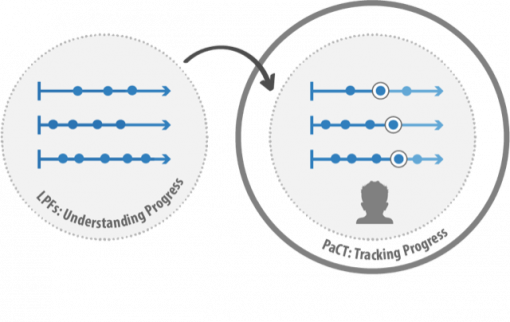
The Progress and Consistency Tool (PaCT)
Tracking Progress
The Progress and Consistency Tool (PaCT):
Tracking Progress
The Progress and Consistency Tool (PaCT): Tracking Progress
What is the Progress and Consistency Tool?
PaCT is a tool designed to help teachers make dependable judgments about students' achievement that can be used to track progress in reading, writing, and mathematics.
Teachers locate students on the Learning Progression Frameworks (LPFs) as they make judgments in PaCT. PaCT guides teachers to make best-fit decisions about their students' achievement in each of the aspects of the reading, writing, and mathematics frameworks.

PaCT synthesises a teacher's aspect judgments into a PaCT scale score which is displayed in relation to the levels of the New Zealand Curriculum (NZC).
PaCT is an international first because it includes psychometrically calibrated measurement scales that are based on teachers' judgments of student achievement rather than direct assessments of the students themselves. The PaCT scale is a linear scale that extends from 0 to 1300. Each part of this scale is associated with a curriculum level.
PaCT generates a number of individual and cohort reports that provide a comprehensive picture of achievement and progress in relation to the LPFs and the NZC.
Reporting is presented at an individual student level, class level, school level, or Kāhui Ako level.
PaCT is securely provided by the Ministry of Education to schools with years 0 to 10 students.
Appropriate Ministry IT staff can access the PaCT dataset. Their role is to support users, investigate reported issues, and maintain the system. Researchers may request to use data from PaCT. All identifying information about the school and students will be removed from data used for research purposes. This ensures anonymity for students and schools.
How can PaCT help me?
PaCT supports you to make consistent decisions about students’ achievement in reading, writing, and mathematics.
PaCT moderates individual teachers' expectations through the frameworks and illustrations. It provides a common framework for teachers to make and discuss their judgment decisions with one another. Because all teachers use the same frameworks, signposts, and illustrations to make their judgments, they have more confidence that their own and their colleagues’ judgments are consistent and therefore dependable. Teachers’ aspect judgments are synthesised by PaCT to provide a dependable overall judgment.
PaCT gives you dependable information that can be used by everyone.
Students need good feedback so they can plan their own learning goals. Parents and whānau need dependable information so they can support their child's learning. A student's next teacher, at their current or another school, needs to be confident about the information they are receiving about the student. School leadership teams need dependable information to inform their self-review and planning. Boards of Trustees need dependable information to make resourcing decisions.
PaCT allows a student's progress to be tracked within and between schools from school entry to year 10.
PaCT automatically imports student data from ENROL. When students move schools, any data they have in PaCT is available to their current school and is no longer visible to their previous school.
The information from PaCT reports helps guide your decisions about teaching programmes.
Teachers are able to track students’ and class progress and use the data to inform teaching programmes and guide decisions about how to improve students' learning. School and Kāhui Ako leaders have dependable information on progress in their school or Kāhui Ako and on areas where extra support might be needed. Boards of Trustees are able to track progress towards their school’s goals and targets and plan for the school's future.
PaCT helps you give specific feedback to students, parents, and whānau.
The student progress report provides comprehensive information about a student's achievement and progress in relation to the NZC that is useful for conversations about student learning. The signpost descriptors and illustrations used when making aspect judgments for a student are a source of information for comments about that student's achievement. The selected signposts can help identify possible strengths or gaps for a student.
PaCT supports assessment for learning by prompting you to notice the important aspects of students’ reading, writing, and mathematics.
The breakdown of reading, writing, and mathematics into aspects gives greater clarity about what to notice when observing and interacting with students. The PaCT illustrations help to give teachers confidence that their judgments, based on their professional knowledge and observations of students engaging in classroom activities, are valid as the primary source of evidence.